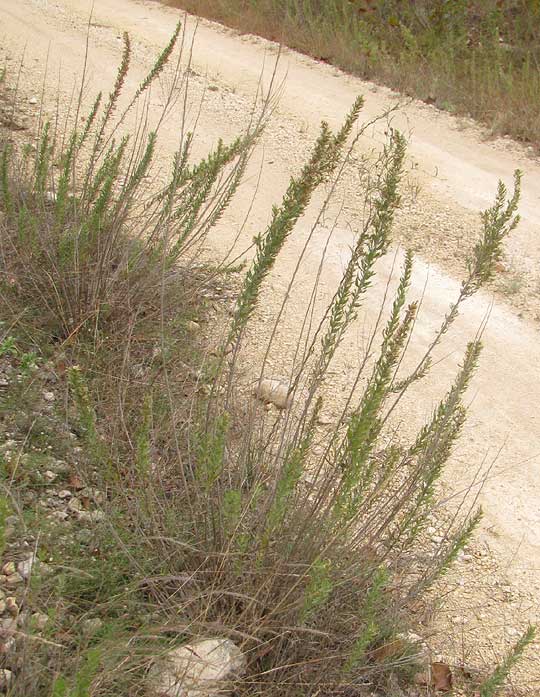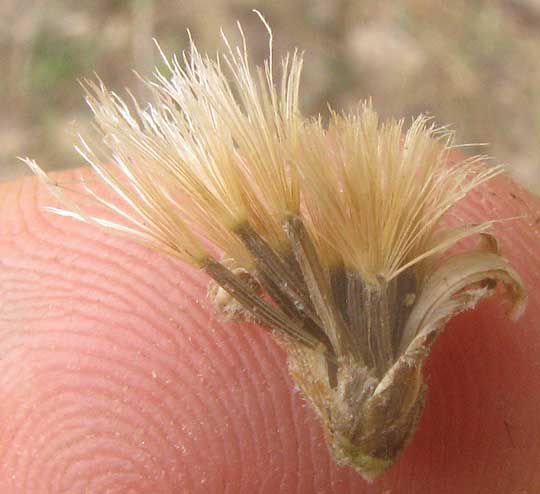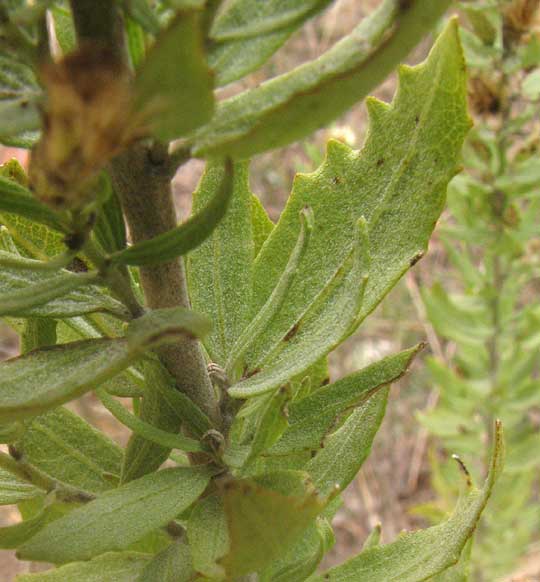Excerpts from Jim Conrad's
Naturalist Newsletter
from the November 3, 2013 Newsletter issued from the Frio Canyon Nature Education Center in the valley of the Dry Frio River in northern Uvalde County, southwestern Texas, on the southern border of the Edwards Plateau; elevation ~1750m (~5750 ft); N29.62°, W99.86°; USA
GRAVELBAR BRICKELLBUSH
Back East I would have ignored as just another Bush Lespedeza or Horseweed the slender, waist-high plant leaning out over the gravel road, but I've not seen those plants here, plus, a second look disclosed that the plant arose from a woody base, while those other ones are herbaceous. Below, you can see a couple of our roadside plants:

Up close, the blossoms were of the eupatorium type, meaning that tiny flowers, or florets, were grouped into heads of the kind found in the Composite or Sunflower Family, and that all the florets were of the slender, cylindrical kind or "disc flowers." There were no petal-like "ray flowers" issuing around the heads' margins. Below, you can see these eupatorium-type flowering heads at the tip of a stem, a little past their prime and with fruit-forming heads below them:

In that picture the stiff, white hairs jutting from lower heads comprise parachute-like pappi atop the cypsela-type fruits. A mature head broken open to show the brown cypselae stacked next to one another, each cypsela crowned with a feathery pappus, is shown below:

The plant's alternating, hairless, tooth-margined leaves are shown below:

Once I focused on the above details it occurred to me that in our October 13 Newsletter we looked at a woody-based, slender, waist-high bush with eupatorium-like flowers very much like this. That was the Brickellbush, Brickellia cylindracea, endemic only to a few counties in central Texas. At that time we took note that about a hundred species of the genus Brickellia are recognized, living in Central America, Mexico, and the US. In the US 32 species are known, mostly in the desert Southwest. In our area, besides October's Brickellbush, two other Brickellia species are to be expected.
In fact, this turns out to be one of those two other species. Sometimes called the Gravelbar Brickellbush, it's BRICKELLIA DENTATA, in general a more robust, woodier and more compactly leafy bush than our previous Brickellbush, plus the former one lived on dry limestone hillsides, while the Flora of North America describes Gravelbar Brickellbush as living on gravel of limestone streambeds. Also, like our previous Brickellbush, in the whole world Gravelbar Brickellbush is found only in a few counties in central and western Texas. Our plants weren't on gravel in a streambed, but they were in roadside gravel in the floodplain of the Dry Frio River, and only a stone's throw from the stream itself.